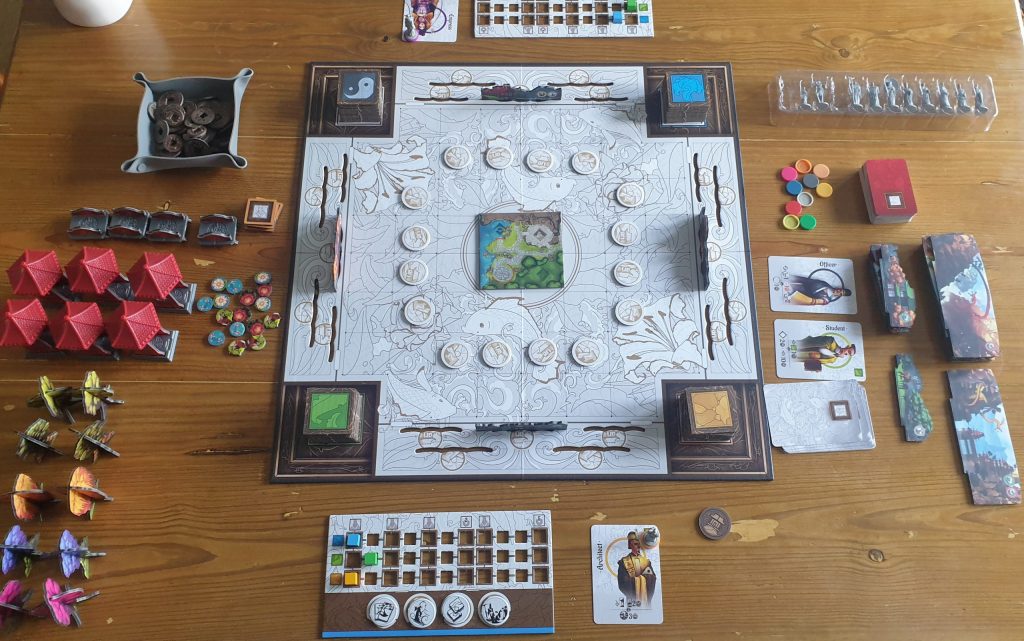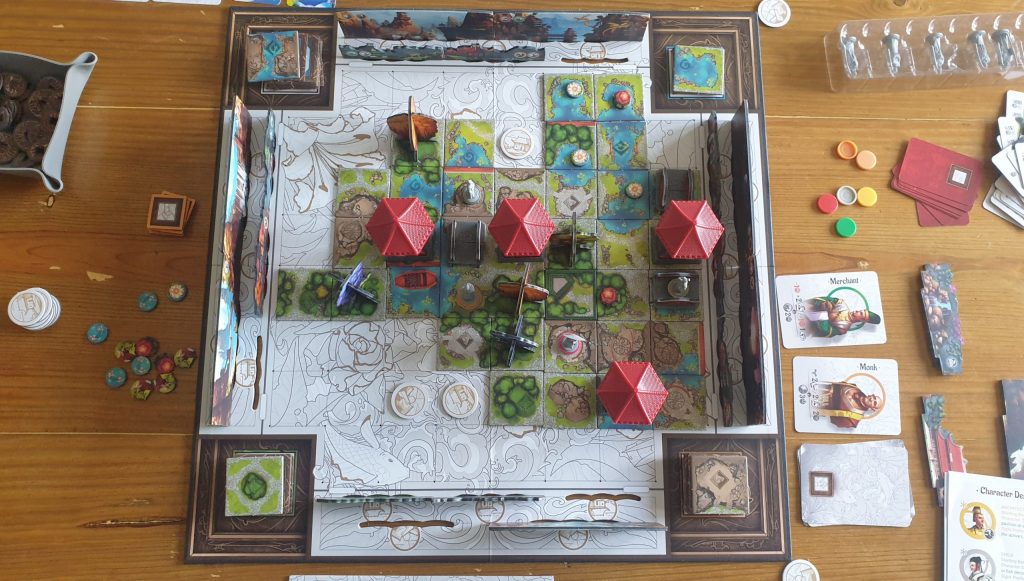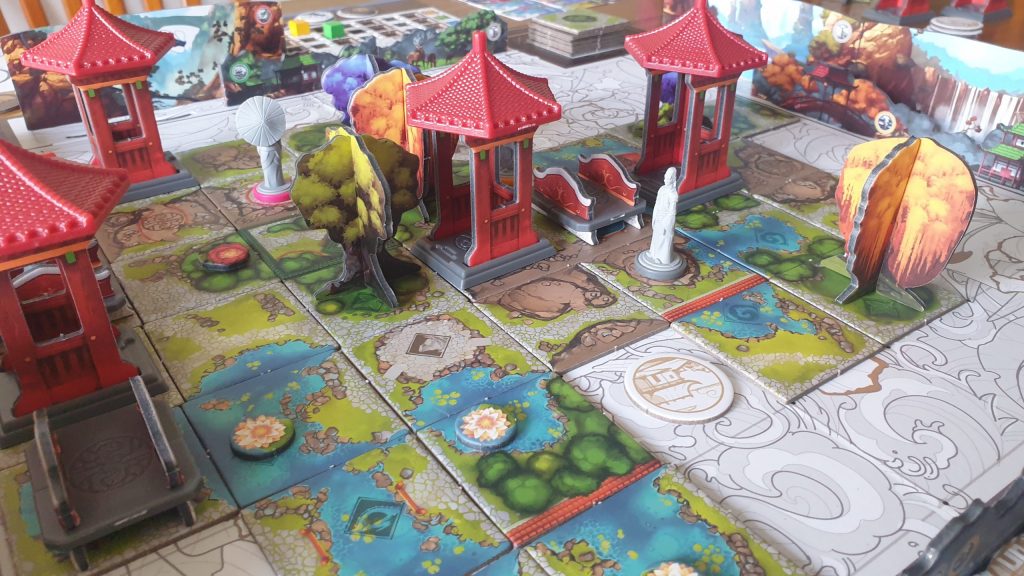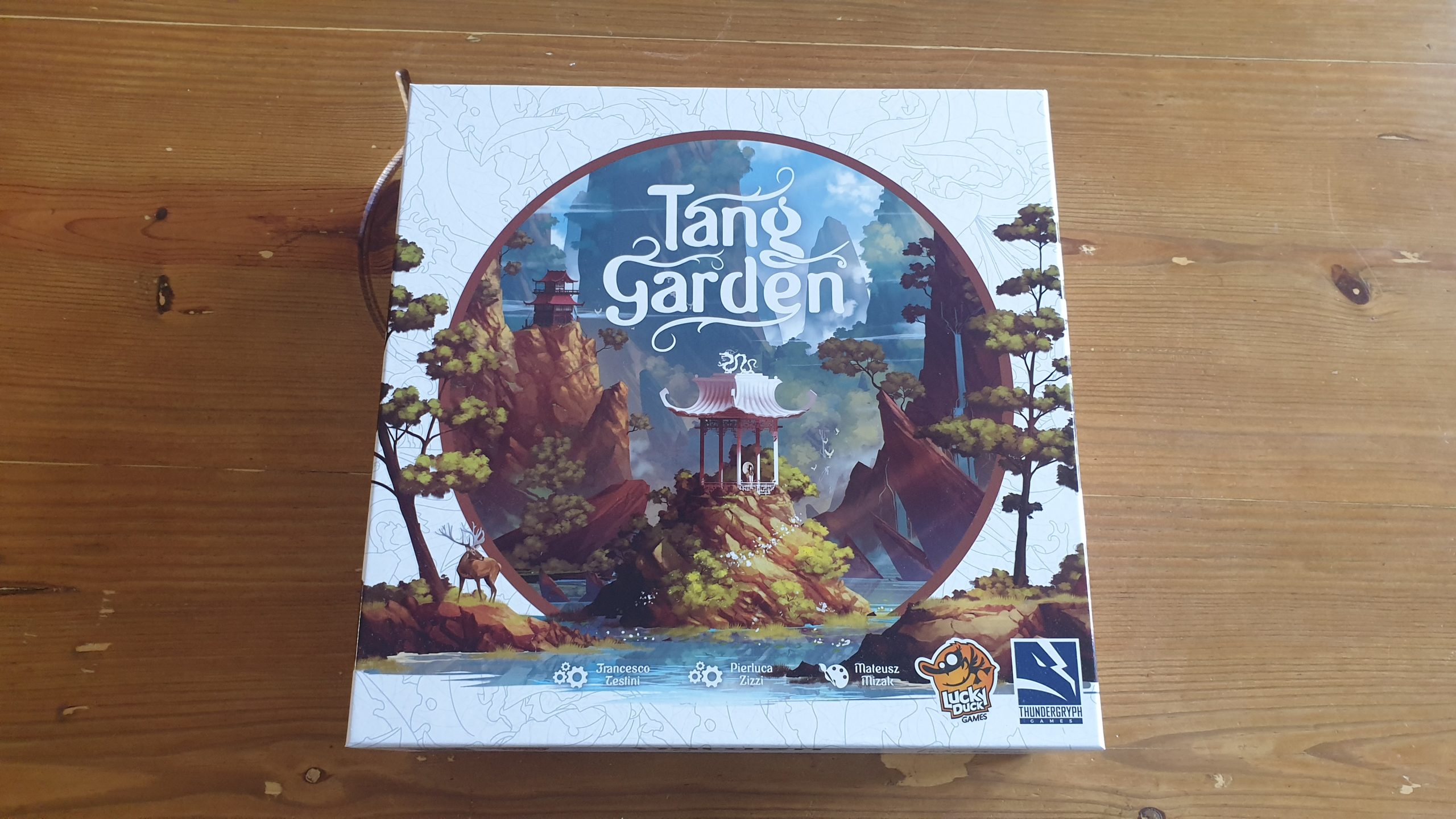Tang Garden is a brand new tile placement board game from publisher ThunderGryph Games. Originally funded on Kickstarter, the game has now had a retail release. Designed by Francesco Testini and Pierluca Zizzi, featuring artwork from Matthew Mizak, the game sees 1 – 4 players design a zen like Chinese garden, for around 45 minutes. With ponds, trees, bridges and more to fill the garden, it is hard to deny the game is anything less than eye-catching. However, is the gameplay as good as the production? Let’s find out!
The central board starts mostly empty. A large double sided starting tile is placed in the middle and 4 small landscape pieces are put randomly into place, one on each side of the board. The tiles are split into 4 piles based on the colour on their reverse – with a pile placed at each corner of the board. Randomly distributing a starting character to each player, they claim the appropriate mini, with the rest of the characters shuffled. Two characters are flipped from this deck to create a sort of market. Each player takes a player board, which has 3 tracks on it (green, yellow and blue), with coloured cubes tracking players’ advancements along them. Whomever last went to China is then the starting player, or it can be decided randomly.
On a turn players have the choice between two actions, with the opportunity to then perform bonus actions. Players must either expand the garden, by placing a face up tile from one of the four stacks, or add to its beauty with decorations. Tiles will expand the garden and earn the player advancements on the trackers and/or coins. Tiles must continue the garden, being placed adjacent to other tiles, and match the terrain on the edges of tiles. When matching terrain types the player can move the cube of that type up on their personal player board, with matched paths rewarding coins. Multiple matches can be made, if two or more edges match up, for bigger gains on a turn. Importantly, the top tile of the stacks are not flipped unless fewer than 2 piles feature a face up tile – limiting the options of others.

Instead, players can draw decoration cards. Taking 2 cards by default, plus 1 per facedown tile stack, the player chooses one decoration. These range from trees, which score based on the number of types, to pavilions, that award 12 points to whoever builds the most. Decorations must be added to specific icons on the tiles. For example, Koi fish can only be added onto the water area icon. If an appropriate icon is not free in the garden then that decoration cannot be chosen. Whenever this action is taken then the garden tile stacks that have facedown tiles see the top ones flipped.
There are 4 bonus actions that players can take, each being one time abilities. Directly related to the two main actions players can flip the associated bonus token to double their turn, placing two tiles or two decorations. The third token allows a player to move one of their characters in the garden to any other available spot, which is handy for scoring. The final power is used when a new character or a landscape piece is chosen – with the choice widened to the entire selection, not just the next up available pair. Landscape pieces are added when a player places a garden tile on specific spaces in the garden. They are not just for the visual flair they add, they each have symbols on them for end game scoring.
12 characters are included, with 6 of these being denoted as starting characters. Characters have ongoing special abilities which the player can exploit, until the character is placed into the garden. These range from gaining a coin for advancing up one of the tracks to being able to pay to refresh the facedown tile stacks. When a player gets all three of their advancement trackers up to specific levels they can claim a new character – from the two available. This sees a new character card and mini claimed, with either of the character minis then placed into the garden. Like decorations there are only certain places that characters can be placed, with their direction actually mattering.
At the end of the game your character minis will earn coins based on what they can see, in the direction they face – often including the landscape pieces that are placed around the edge of the board. The game continues clockwise around the table, until either a garden tile stack runs out or three or fewer landscape tokens remain on the board. At this stage it is time to point up. Points are earnt from coins collected during play, for the characters in the garden and decorations. Whomever has the most points at the end of the game is the winner!

Tang Garden isn’t quite a point salad, though almost every action will help players towards one method of scoring points. Placing tiles can earn coins or help the player progress towards gaining another character. The range of decoration cards offers a number of ways to score points – commonly from specific sets of decorations. Due to this, no move feels like it is bad for the player with both routes potentially helping the player to score big.
From a learning perspective the amount of symbology used is daunting for some, making the game seem more complicated than it actually is. There is a consistency to the symbology used across Tang Garden though. In the first playthrough you’ll be referencing the back of the rulebook for the character powers – almost every time a new character comes into play. By the end of the first game the symbology will have been learnt and even previously unseen powers can be worked out. It is a small learning curve as with any other icon heavy title, though it is worth it – plus it helps that a lot of the icons are repeated.
On each turn players have a choice of what to do, expand the lush garden or add to it in the form of trees, koi or even birdhouses. For much of the game there is a choice to be made. At times though it is blindingly obvious which is the better option. Almost forcing players one way or the other are the number of cards and tiles players can choose from. After a couple of tile turns there will be two to pick from, and at this point drawing decoration cards will see 4 drawn. Reverse this and when only two decoration cards will be drawn four tiles will be visible to pick from. This can see players falling into a bit of a rut, taking the same action over and over because of how this option keeps presenting itself. With the decoration cards unknown, the logic is only really broken when a great tile is left on a stack – which is rare unless you can spot a great placement that others miss.
The optional bonus actions on a turn all feel powerful, allowing the player to combo a couple of tile placements together or instantly claim a scoring pair of decorations. It is however the manipulation of the characters that is where huge point gains can come from. Not just shifting a character’s location on the board but also what they can see can be huge, to score plenty from decorations. Then there is the ability to search for a specific landmark piece or a specific character. Chosen early on you can line yourself up for a lot of points or near the end grab someone you know will score well given the layout of the board. The latter powers certainly become stronger as you play more of Tang Garden and start to know the powers and abilities, without needing to refer to the back of the rulebook.

Starting off as a strikingly white board over the course of the tile placement gameplay it fills with colour. The vibrant colours of the terrain makes the game pop from the table, catching people’s attention. Literally on top of that, the decorations then add glorious flair to the already beautiful board. As glorious as the pavilions and bridges are, and to a lesser extent the trees too, they somewhat block players’ view of the board. It limits the readability of the board at a glance, as what is on the tile underneath, what terrain type to match to, isn’t clear.
With a bit of head bobbing it is fine. The real reason behind this is that the pavilions and bridges are designed to be large enough to enable the miniatures to stand on them. While the pavilions feel like they should be the size they are, the bridges seem to wide, taking up the majority of the tile they are placed on. Not even for those that are colourblind, it is extremely hard to tell the different shades of yellow, orange and light peach apart, and also the pink-purple pair of characters. The models are different but the colour could have been used to boost the readability of the board at a glance – instead players have to study the board a bit to work out which character is which.
Before play all of the pavilions, bridges and trees must be constructed – and this is no mean feat. Taking a good 20 minutes from punching the pieces out to having them all ready to go, you’ll want to do this ahead of game time. Thankfully, the insert is designed to house all of the components in their built form. So, there’s no need to repeat this process, not even for the trees. Aside from needing a couple of plastic baggies to stop the coins and smaller cardboard tokens from being loose in the box, this is a great example of a game box done right.
Not everything about Tang Garden is perfect, though it is far from style over substance. It has the stunning style: the vibrant board that grows during play, the pavilions and the trees. There is also a solid game underneath, that keeps players wanting to come back for more. There are times when your choice of which action to take seems limited, with one obvious choice available. Even in these moments players aren’t left choiceless – there is always a choice between at minimum two tiles or cards and then where to place it. The jaw dropping components will get Tang Garden to the table, with the gameplay earning its spot on any gamer’s shelf!
(Editor’s Note: Tang Garden was provided to us by Asmodee for the review. The game is currently available from local board game stores! Find your local store here.)

